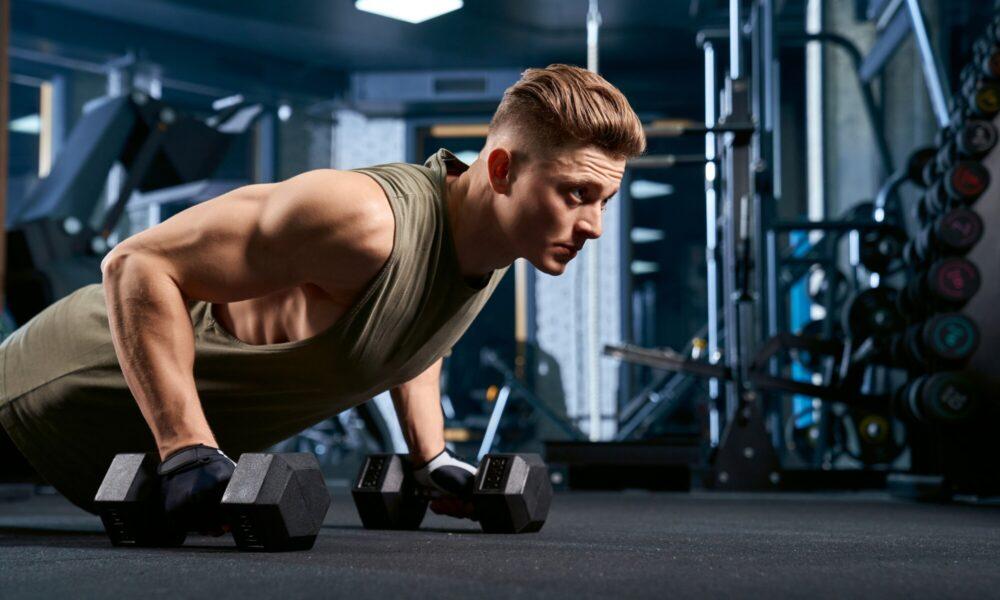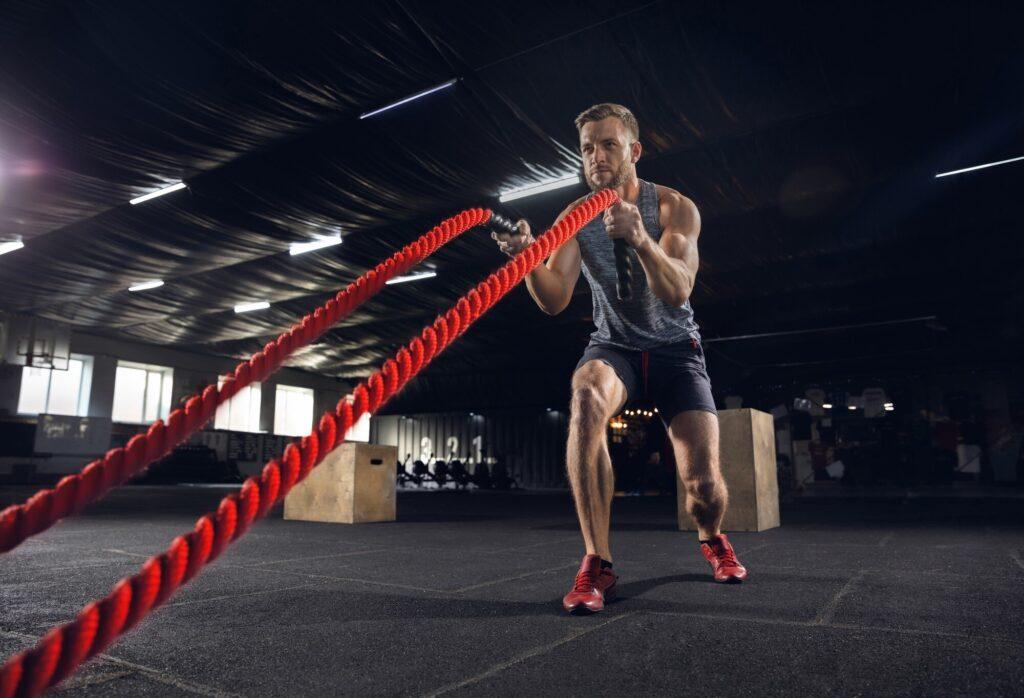[ad_1]

As summer is right around the corner, we all aspire to achieve a lean and toned physique. One of the most efficient and effective methods to burn fat and build muscle for a shredded physique is High-Intensity Interval Training (HIIT).
HIIT workouts are designed to push your body to its limits through short bursts of intense exercise followed by brief periods of rest or low-intensity activity. This training maximizes calorie burn and enhances cardiovascular fitness and metabolic rate.
This article explores HIIT and its benefits, the top HIIT workouts, how to get started, and essential tips for integrating it into your fitness regimen for optimal results leading into summer.
HIIT, also known as High-Intensity Interval Training, is a strategy that alternates short bursts of intense exercise—usually less than 20 seconds, followed by less intense recovery periods. The high-intensity intervals push your body to its limits, elevating your heart rate and challenging your muscles. At the same time, the recovery periods allow you to catch your breath and partially recover before the next intense workout.
HIIT is known for its effectiveness in burning calories, improving cardiovascular health, weight loss, improving performance, and boosting metabolism in a shorter period. For this reason, most bodybuilders enjoy doing it.
Another cool thing about HIIT is that it doesn’t hog all your time. You can get an amazing workout in under an hour. However, you must work hard to achieve high intensity during that period. You must get your heart rate above 80 %—95% of your maximum before slowing down to recovery. This means it should be hard enough to prevent you from having a normal conversation.
The high intensity allows you to burn more fat and calories in a shorter period than if you had done regular steady-state cardio.

High-Intensity Interval Training (HIIT) offers several benefits for bodybuilders, enhancing both muscle growth and overall fitness. Here are eight detailed benefits of incorporating HIIT into a bodybuilding routine:
1. Muscle Retention
While traditional steady-state cardio can sometimes lead to muscle loss, high-intensity interval Training (HIIT) promotes muscle retention. It is an attractive option for those who want to preserve lean muscle mass while reducing body fat.
During HIIT sessions, the intense bursts of activity create micro-tears in muscle fibers, prompting the body to repair and rebuild them stronger and denser. This continuous cycle of muscle breakdown and repair contributes to muscle retention by ensuring that existing muscle mass is preserved even during periods of calorie deficit.
HIIT promotes the secretion of anabolic hormones, such as testosterone and growth hormone that support muscle growth and preservation. These hormones regulate protein metabolism, enhancing muscle protein synthesis and inhibiting muscle protein breakdown.
2. Increased Fat Loss
HIIT is highly effective for quickly burning body fat, especially belly fat. The intense bursts of exercise followed by short recovery periods elevate the metabolic rate, leading to greater calories burned during and after the workout.
According to research, teenage women with obesity were found to have reduced belly fat after doing high-intensity interval training than those who did traditional aerobic exercise.
Another study shows that HIIT can enhance the amount of fat burned during the workout by as much as 25%. This is due to the continued effect of burning calories after training.
3. Increased Resting Metabolic Rate
The resting metabolic rate is the calories you burn while you rest. The more muscles you have, the higher the resting metabolic rate.
During the intense intervals, your body depletes its oxygen stores, leading to an oxygen deficit. To balance this, your body increases its oxygen consumption post-exercise to restore muscle glycogen, remove lactate, and repair muscle tissue. This afterburn” effect process elevates your metabolic rate for several hours, sometimes up to 24 hours, depending on the intensity and duration of the workout.
HIIT can improve insulin sensitivity, allowing your body to utilize nutrients more effectively and maintain a higher metabolic rate. It also stimulates the release of hormones such as adrenaline and noradrenaline. These hormones increase fat oxidation and mobilize fat stores for energy, thus elevating your resting metabolic rate.

4. Improved Cardiovascular Health
One of the main benefits of high-intensity interval training is its ability to strengthen the heart and improve overall health quickly.
The short bursts of intense exercise push your heart rate to near-maximum levels. This high demand on the cardiovascular system forces the heart to pump more blood to the muscles. Over time, this improves the heart’s ability to pump blood, strengthening the heart muscle and increasing cardiovascular endurance.
HIIT reduces blood pressure, bad cholesterol (LDL), and triglyceride levels. Lower blood pressure reduces the risk of cardiovascular diseases such as heart attack and stroke. In contrast, a healthier lipid profile reduces the risk of plaque buildup in arteries, promoting overall cardiovascular health.
5. Time Efficiency
HIIT workouts are typically shorter than traditional workout and cardio sessions, providing similar or more significant benefits. This makes it suitable for anyone with limited time. You can go workout and do cardio or do both with HIIT.
6. Burn More Calories
High-intensity interval training may be the best workout to burn calories and fat rather than a fasted or steady-state cardio workout. This is because it burns more calories within a short period. In fact, according to studies, the amount of calories HIIT burn in 30 minutes is more than the amount of calories burned by steady-state cardio.
HIIT workouts can also trigger the afterburn effect, known as excess post-exercise oxygen consumption (EPOC), where the body continues to burn calories at a higher rate even after the workout is finished to recover, repair, and return to a resting state.
7. Muscle Endurance
HIIT improves muscle endurance by training the body to perform at high intensities. This can translate to improved performance during weightlifting workouts.
8. Variety and Adaptability
HIIT workouts include various exercises, from running and cycling to bodyweight exercises like burpees and squats. This variety helps keep workouts exciting and prevents boredom.
Also, you can do HIIT anywhere, with or without equipment, and tailor it to target specific muscle groups or fitness goals, such as improving strength, endurance, or overall fitness.

The following types of HIIT workouts can help you get in shape for the summer.
1. Tabata HIIT Workout
Tabata is a form of HIIT that involves 20 seconds of maximum effort followed by 10 seconds of rest. One round of Tabata consists of eight sessions lasting four minutes. Start with a five-minute warm-up, followed by one round of eight sets. During each set, ensure you perform as many repetitions as possible. After the first round, rest for one minute before doing the next round until you have exhausted all four rounds. Finish with a 10-minute cooldown.
Do two sets of each workout (each for 20 seconds, with a 10-second break, before you move to the next workout. Rest for one minute after every round.
| Round 1 | Round 2 | Round 3 | Round 4 |
|---|---|---|---|
| Squat Jumps | Jump Lunges | Skaters | High/low boat |
| Jumping jacks | Kettlebell Swings | Dumbell Goblet Squat | Line jumps |
| Burpees | Lateral Shuffles | Plank punches | Russian twists |
| Push-Ups | High Knees | Jump rope | Lunges |
2. Circuit Training Workout
Circuit training involves completing a series of exercises in sequence with minimal rest between them. Each exercise targets a different muscle group. Perform the following workouts in circuit 1 for 45 seconds and rest for 15 seconds before moving to the next, and 40 seconds and 20 seconds rest in circuits 2 and 3. Repeat each circuit four times.
| Circuit 1 | Circuit 2 | Circuit 3 |
|---|---|---|
| Push-ups | Squats | Jumping Jacks |
| Lunges | Sit-ups | Bicycle Crunches |
| Plank | Jump Rope | Tricep Dips |
3. Bodyweight HIIT Workout
Bodyweight HIIT workouts are a form of High-Intensity Interval Training that uses only your body weight as resistance. They are accessible and convenient because they require no equipment. Before you start, warm up for 5 minutes by doing jumping Jacks and dynamic stretches.
HIIT Routine (20 minutes)
Perform the following workouts for 45 seconds and rest for 15 seconds before moving to the next. Repeat each round 3 times.
| Round 1 | Round 2 | Round 3 | Round 4 |
|---|---|---|---|
| Burpees | Jump Squats | Push-ups | Mountain Climbers |
| Plank Jacks | Jumping Jacks | Butt Kicks | High Knees |
| Jump lunges | Lateral Frogger | Air Squats | Step-ups |
4. Full Body HIIT Workout
Perform the following workouts for 40 seconds and rest for 20 seconds before moving to the next. Repeat each circuit 2 times with a 1-2 minute rest between circuits.
| Round 1 | Round 2 | Round 3 |
|---|---|---|
| Burpees | Hip Switch | Donkey Kicks |
| Push-Ups | Plank to Shoulder Tap | Side Lunge and Knee Crunch |
| Mountain Climbers | Jump Squats | Toe taps |
5. Cardio and Core HIIT Workouts
You should perform each of the following exercises for 40 seconds, followed by 20 seconds of rest before the next exercise.
Repeat this circuit 3-4 times with a 1-2 minute rest between circuits.
6. Upper Body HIIT Workouts
Do each of the following exercises for 40 seconds, followed by 20 seconds of rest before moving to the next.
- Push-Up Variations (regular, wide, tricep): Pike Push-Ups: 40 seconds on, 20 seconds rest
- Renegade Rows
- Plank Ups
- Tricep Dips (using a bench or chair)
Repeat this circuit 3-4 times with a 1-2 minute rest between circuits.
7. Lower Body HIIT Workout
Perform each of the following exercises for 40 seconds, followed by 20 seconds of rest before the next exercise.
- Jump Squats
- Alternating Reverse Lunges
- Glute Bridges
- Sumo Squats
- Calf Raises
Repeat this circuit 3-4 times with a 1-2 minute rest between circuits.

[ad_2]
Source link
Fitnessnacks – #High #Intensity #Interval #Training #HIIT #Workouts
Courtesy : https://www.ironmanmagazine.com/high-intensity-interval-training-hiit-workouts-to-try/
